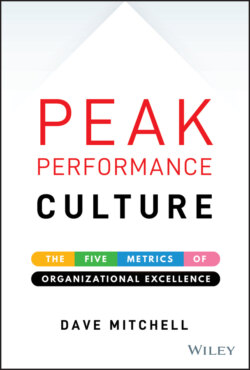Peak Performance Culture

Реклама. ООО «ЛитРес», ИНН: 7719571260.
Оглавление
Dave Mitchell. Peak Performance Culture
Table of Contents
List of Tables
List of Illustrations
Guide
Pages
PEAK PERFORMANCE CULTURE. THE FIVE METRICS OF ORGANIZATIONAL EXCELLENCE
Preface
Acknowledgments
Introduction
“FAT ENOUGH, HAPPY ENOUGH” ISN'T ENOUGH
WHAT YOU'LL FIND IN THE BOOK
THE PLAN REQUIRES WORK
Chapter 1 A Foundation of Passion
TRUE PASSION IS RARE
DESIRE VERSUS PASSION
THE IMPORTANCE OF JOY
LEADING WITH PASSION
Key Considerations
Chapter 2 Horizontal Alignment
SUCCESS SCOREBOARD
First Measure: Profit
Second Measure: Efficiency
Third Measure: Stakeholder Satisfaction and Retention
Importance of Customer Satisfaction
The Need for Customer Retention
Employees as Stakeholders
MARKET ENVIRONMENT
WHY ME? THE CORE IDEOLOGY
Makeup of a Core Ideology
Comparing Two Wineries' Core Ideologies
HOW DO YOU IDENTIFY YOUR CORE IDEOLOGY?
Spend Some Time Evaluating the Leadership Team's Culture
Trust
Engagement
Idea Generation
Collaboration
Clear Expectations
Spend Time Thinking About the Market Environment
Spend Time Honestly Evaluating Your Current State
Determine the Desired Future State
Will Our Core Ideology Be Reflective or Aspirational?
I'll Have the Combo Please
Generative Positions and Core Ideology
Construct the Core Ideology
THE FIRST STEP OF ALIGNMENT IS DONE
Key Considerations
Chapter 3 Vertical Alignment
VERTICAL ALIGNMENT SHOULDN'T BE AN AFTERTHOUGHT
THE INCREDIBLE VALUE OF A WELL‐DESIGNED JOB DESCRIPTION
A MISALIGNED BRAND
DIGGING DEEPER INTO ALIGNMENT
THE MISALIGNED SALES PROCESS
BRAND STATEMENT AND VERTICAL ALIGNMENT
THE FALLACY OF “DISRUPTION”
SMALL CHANGES IN HORIZONTAL ALIGNMENT CREATE BIG CHANGES IN VERTICAL ALIGNMENT
VERTICAL ALIGNMENT AT THE DIVISIONAL/DEPARTMENTAL LEVEL
Step One: Identify Your Current State
Step Two: Identify the Desired Future State
Step Three: Will the New Practice Align with the Organization's Core Ideology?
PASSION IS THE FOUNDATION, ALIGNMENT IS THE INFRASTRUCTURE
Key Considerations
Chapter 4 Leadership Ideology
THE PROBLEM WITH VALUES
THE IMPORTANCE OF BEHAVIORS
INTERNAL LOCUS OF CONTROL
AN EMPOWERMENT CULTURE
INTRINSIC NEEDS FULFILLMENT
DIALECTICAL THINKING
ZERO‐BASED THINKING
COACHING AND COUNSELING TO SHIFT RESPONSIBILITY
PEOPLE PREVENTATIVE MAINTENANCE SYSTEM
SEAMWORK
LEADERSHIP TOXICITY
THE GREAT EIGHT OF BENEVOLENT ACCOUNTABILITY AND PRAGMATIC CREATIVITY
Key Considerations
Chapter 5 The Customer Experience
NOT ALL CUSTOMERS ARE ALIKE
THE HEART AND ART OF SERVICE EXCELLENCE
SERVICE EXCELLENCE AND ORGANIZATIONAL ERGONOMICS
SERVICE RECOVERY
CUSTOMER JOURNEY MAPPING AND THE POWER OF EXPECTATIONS
Anticipated Experience
Critical Interactions
Journey Mapping
Filtering
Client Advisory Boards
Client Awareness Councils
The Lifespan of Boards and Councils
Propulsion
Confusion
Frustration
Revision or Division
Reignition or Dissolution
The Need for a CAB and CAC
Sample of Piramal Pharma Solutions Charter
The Mission of the Patient Awareness Council
Council Structure
Council Responsibilities
Selection Process and Leadership
Council Meeting Protocols
Training
Council Expectations
Questions? Suggestions? Comments?
Example of Patient Awareness Council Welcome Letter
Key Considerations
Chapter 6 The Employee Experience
RECRUITING AND SELECTION
Ongoing Recruitment
Imagining the Ideal Candidate
Recruiting and Selection Checklist
Assessing an Applicant's Locus of Control
NEW HIRE ONBOARDING/ORIENTATION
SKILLS TRAINING
CONTINUOUS COACHING AND PERFORMANCE FEEDBACK
CAREER PATHING
THE EMPLOYEE/CUSTOMER LINK
Key Considerations
Chapter 7 It's Go Time!
Appendix: Peak Performance Culture The Five Metrics of Organizational Excellence
PEAK PERFORMANCE CULTURE ASSESSMENT
ONGOING ENHANCEMENT
HORIZONTAL ALIGNMENT ASSESSMENT (Refer to Chapter 2)
VERTICAL ALIGNMENT ASSESSMENT (Refer to Chapter 3)
LEADERSHIP IDEOLOGY ASSESSMENT (Refer to Chapter 4)
CUSTOMER EXPERIENCE ASSESSMENT (Refer to Chapter 5)
EMPLOYEE EXPERIENCE ASSESSMENT (Refer to Chapter 6)
About the Author
Index
WILEY END USER LICENSE AGREEMENT
Отрывок из книги
DAVE MITCHELL
It was January 2012. Verona, Italy. My 16‐plus years (at that time) as an international speaker on organizational development did not prepare me for what I was about to experience. The 12 years I'd worked in corporate human resources development before that also failed me. Nothing about the chain of events leading up to this moment foretold the incredible reveal that would happen at an auditorium within a vibrant pharmaceutical research and manufacturing facility.
.....
“What? How can this be?” I thought to myself. How is it that these incredibly knowledgeable chemists, technicians, and researchers would be so emotionally sensitive? It had not occurred to me that these professionals were not merely drawn to the science of health care, but also to the service of others.
It was at this moment that I knew that the organization had a core ideology that could differentiate it from its competitors. This corporate culture was unique, possessing not just the technical expertise to enhance the work of those clients whom they supported, but also a passion for helping others. We already knew they had a head for science, but we discovered that day that they also had a heart for service.
.....